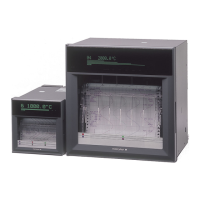5-9
IM 04P01B01-17E
5
Responses
Each status is set to H, L, h, l, R, r, T, t, or space.
H: high limit alarm, L: low limit alarm, h: difference high-limit
alarm, l: difference low-limit alarm, R: high limit on rate-of-
change alarm, r: low limit on rate-of-change alarm, T: delay
high limit alarm, t: delay low limit alarm, space: no alarm
uuuuuu Unit information (6 characters, left-justified)
mV____: mV
V_____: V
^C____: °C
xxxxxx: (User-defined character string)
f
1
Sign (+, –) of mantissa
• Positive over data, error data, and the burnout data when
“up” is specified are positive.
• Negative over data and the burnout data when “down” is
specified are negaitive.
ddddd Mantissa (00000 to 99999, 5 digits)
•8 digits for computed data.
• For error data (channel data status is E), over data (channel
data status is O), or burnout data (channel status data is B),
the mantissa is set to 99999 (99999999 for computed data).
f
2
Sign (+, –) of exponent
pp Exponent (00 to 04)
_ Space
• Example
EA
DATE 99/02/23
TIME 19:56:32.500
N 001h mV +12345E-03
N 002 mV -12345E-01
S 003
EN
Note
• Data for non-existing channels are not output (not even the channel number).
• For channels set to skip, output values from alarm status to exponent are spaces.
5.2 Output Format of ASCII Data

